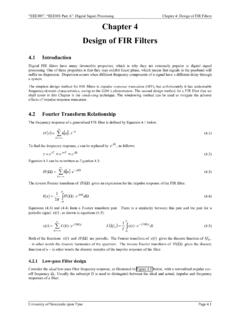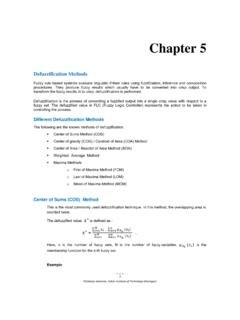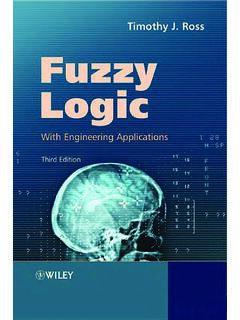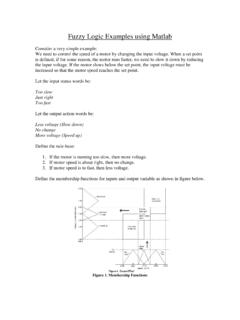Transcription of Takagi-Sugeno Fuzzy Modeling for Process Control
1 Takagi-Sugeno Fuzzy Modeling for Process ControlKamyar MehranIndustrial Automation, Robotics and Artificial Intelligence (EEE8005)School of Electrical, Electronic and Computer EngineeringNewcastle University 2008 Contents1 Introduction12 Takagi-Sugeno Fuzzy Construction of Fuzzy Models .. Sector Nonlinearity .. Basic Fuzzy Mathematics for Modeling .. Local Approximation in Fuzzy Partition Spaces .. 103 Appendix17 References18iiChapter 1 IntroductionAlmost all of the physical dynamical systems in real life cannot be represented by lin-ear differential equations and have a nonlinear nature. At the same time, linear controlmethods rely on the key assumption of small range of operation for the linear model,acquired from linearizing the nonlinear system, to be valid.
2 When the required operationrange is large, a linear controller is prone to be unstable, because the nonlinearities inthe plant cannot be properly dealt with. Another assumption of linear Control is that thesystem model is indeed linearizable and the linear model is accurate enough for buildingup the controller. However, the highly nonlinear and discontinuous nature of many, forinstance, mechanical and electrical systems does not allow linear approximation. It is alsonecessary, in the design Process of controllers, that the system model is well achievablethrough a mathematical model and the parameters of the system model are reasonablywell-known. Nevertheless, for many nonlinear plans chemical processes, building amathematical model is very difficult and only the input-output data yielded from runningthe Process is accessible for an estimation.
3 Many Control problems involve uncertaintiesin the model parameters. A controller based on inaccurate or obsolete values of the modelparameters may show significant performance degradation or even instability. There aresome complicated approaches like auto-regressive model based on the input-output data tocompensate model uncertainties, which usually use to design a Process Control . Howeverdue to the high nonlinearity of the Process , the order of the model often becomes veryhigh so that past effects are taken into account, even if that is physically way to cope with such difficulty is to develop a nonlinear model composing of anumber of sub-models which are simple, understandable, and responsible for respectivesub-domains.
4 The idea of multi-model approach [1] is not new, but the idea of fuzzymodeling [2] using the concept of the Fuzzy sets theory [3] offers a new technique to buildmulti-models of the Process based on the input-output data or the original mathematicalmodel of the system. Facing complex and nonlinear systems, we have to recognize thatmodeling is an art and it is important to realize system Modeling is generally an act tounderstand things directly rather than by computer. At most a linear combination like afuzzy model is clearly Fuzzy model proposed by Takagi and Sugeno [2] is described by Fuzzy IF-THEN rules which represents local input-output relations of a nonlinear system.
5 The main featureof a Takagi-Sugeno Fuzzy model is to express the local dynamics of each Fuzzy implication(rule) by a linear system model. The overall Fuzzy model of the system is achieved byfuzzy blending of the linear system models. In this tutorial, the reader will find, bysome examples, that almost all nonlinear dynamical systems can be represented by Takagi-Sugeno Fuzzy models to high degree of precision. In fact, it is proved that Takagi-Sugenofuzzy models are universal approximators of any smooth nonlinear system [4,5].1 Chapter 2 Takagi-Sugeno Fuzzy modelingA Fuzzy controller or model uses Fuzzy rules, which are linguistic if-then statements involv-ing Fuzzy sets, Fuzzy logic , and Fuzzy inference.
6 Fuzzy rules play a key role in representingexpert Control / Modeling knowledge and experience and in linking the input variables offuzzy controllers/models to output variable (or variables). Two major types of Fuzzy rulesexist, namely, Mamdani Fuzzy rules and Takagi-Sugeno (TS, for short) Fuzzy first start with the familiar Mamdani Fuzzy systems. A simple but representativeMamdani Fuzzy rule describing the movement of a car is:IFSpeedisHighANDA ccelerationisSmallTHENB rakingis (should be)Modest,whereSpeedandAccelerationare input variables andBrakingis an output variable. High, Small, and Modest are Fuzzy sets, and the first two are called input fuzzysets while the last one is named the output Fuzzy variables as well as linguistic terms, such as High , can be represented by math-ematical symbols.
7 Thus, a Mamdani Fuzzy rule for a Fuzzy controller involving three inputvariables and two output variables can be described as follows:IFx1isM1 ANDx2isM2 ANDx3isM3 THENu1isM4, u2isM5,( )wherex1,x2, andx3are input variables ( , error, its first derivative and its secondderivative), andu1andu2are output variables ( , valve openness). In theory, thesevariables can be either continuous or discrete; practically speaking, however, they shouldbe discrete because virtually all Fuzzy controllers and models are implemented using ,M2,M3,M4, andM5are Fuzzy sets, and AND are Fuzzy logic ANDoperators. IFx1isM1 ANDx2isM2 ANDx3isM3 is called therule antecedent,whereas the remaining part is named therule structure of Mamdani Fuzzy rules for Fuzzy Modeling is the same.
8 The variablesinvolved, however, are different. An example of a Mamdani Fuzzy rule for Fuzzy modelingisIFy(n) isM1 ANDy(n 1) isM2 ANDy(n 2) isM3 ANDu(n) isM4 ANDu(n 1) isM5 THENy(n+ 1) isM6( )whereM1,M2,M3,M4,M5, andM6are Fuzzy sets,y(n),y(n 1), andy(n 2) are theoutput of the system to be modeled at sampling timen,n 1 andn 2, ,u(n) andu(n 1) are system input at timenandn 1, respectively;y(n+ 1) issystem output at the next sampling time,n+ , let us look at the so-called TS Fuzzy rules. Unlike Mamdani Fuzzy rules, TSrules use functions of input variables as the rule consequent. For Fuzzy Control , a TS rule2corresponding to the Mamdani rule ( ) isIFx1isM1 ANDx2isM2 ANDx3isM3 THENu1=f(x1, x2, x3), u2=g(x1, x2, x3),wheref() andg() are two real functions of any type.
9 Similarly, for Fuzzy Modeling , a TSrule analogous to the Mamdani rule ( ) is in the following form:IFy(n) isM1 ANDy(n 1) isM2 ANDy(n 2) isM3 ANDu(n) isM4 ANDu(n 1) isM5 THENy(n+ 1) =F(y(n), y(n 1), y(n 2), u(n), u(n 1)),whereF() is an arbitrary inference systems also known as Fuzzy rule-based systems or Fuzzy models areschematically shown in Figure They are composed of 5 conventional block: arule-basecontaining a number of Fuzzy if-then rules, adatabasewhich defines the membershipfunctions of the Fuzzy sets used in the Fuzzy rules, adecision-making unitwhich per-forms the inference operations on the rules, afuzzification interfacewhich transform thecrisp inputs into degrees of match with linguistic values, adefuzzification interfacewhichtransform the Fuzzy results of the inference into a crisp output.
10 Figure : Fuzzy inference utilizes a two-rule two-input Fuzzy inference system to show different typesof Fuzzy system mentioned above. Type 2 is the widely-used Mamdani type Fuzzy systemwhich the output function is determined based on overall Fuzzy output; some of them arecentroid of area, min of maxima, maximum of maxima, etc. Type 3 is the Takagi-Sugenotype Fuzzy this tutorial, we focus only on Fuzzy models that use the T-S rule Construction of Fuzzy ModelsFigure illustrates the model-based Fuzzy Control design approach. To design a T-S fuzzycontroller, we need a T-S Fuzzy model for a nonlinear system. Therefore the constructionof a Fuzzy model represent an important and basic procedure in this approach.










